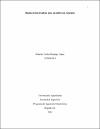Mostrar el registro resumido del documento
Diseño de invernadero para un cultivo de vegetales
| dc.contributor.advisor | Cruz-Guayacundo, Wilmer |
| dc.creator | Durango-López, Roberto Carlos |
| dc.date.accessioned | 2023-08-17T15:29:37Z |
| dc.date.available | 2023-08-17T15:29:37Z |
| dc.date.created | 2023-01-18 |
| dc.identifier.uri | http://repositorio.uniagustiniana.edu.co/handle/123456789/2207 |
| dc.description | El objetivo central de esta tesis es desarrollar las primeras fases de un invernadero inteligente que permita cultivar vegetales representativos de la agricultura colombiana con la finalidad de mejorar la calidad y la cantidad de cultivos bajo techo en el país. Para llevar cabo este proyecto, primero se identificaron diversas problemáticas de los cultivos agrícolas del país y por medio de entrevistas cuáles fueron los requerimientos que solicitaban los agricultores para después poder plantear una solución satisfactoria. Con estos factores se implementó la metodología de diseño que contempla inicialmente la selección del tipo de invernadero a desarrollar por medio de matrices de decisión, luego se empleara la casa de calidad QFD para la definición del producto y se realiza el diseño conceptual para seleccionar el concepto a trabajar, después se realiza el diseño a detalle para poder analizar el concepto seleccionado, seguidamente se realiza el modelamiento 3D con el software Autodesk Inventor en el cual se realizará el análisis de factor de seguridad y la deformación que se pueda presentar, finalmente se lleva el diseño a la realidad por medio de un prototipo y una presentación física. |
| dc.description.abstract | The main objective of this thesis is to develop the first phases of an intelligent greenhouse that allows the cultivation of representative vegetables of Colombian agriculture in order to improve the quality and quantity of indoor crops in the country. In order to carry out this project, we first identified several problems of the country's agricultural crops and through interviews we were able to identify the requirements requested by farmers in order to propose a satisfactory solution. With these factors, the design methodology was implemented, which initially contemplates the selection of the type of greenhouse to be developed by means of decision matrices, then the QFD quality house was used to define the product and the conceptual design was made to select the concept to be worked on, then the detailed design was made to analyze the selected concept, followed by 3D modeling with Autodesk Inventor software in which the safety factor analysis and the deformation that may occur were made, and finally the design was brought to reality by means of a prototype and a physical presentation. |
| dc.format.mimetype | application/pdf |
| dc.language.iso | spa |
| dc.rights | Atribución-NoComercial-CompartirIgual 4.0 Internacional |
| dc.rights.uri | http://creativecommons.org/licenses/by-nc-sa/4.0/ |
| dc.source | reponame:Repositorio Institucional UniARI |
| dc.source | instname:Universitaria Agustiniana |
| dc.subject | Diseño, Invernaderos, Vegetales, Metodología |
| dc.title | Diseño de invernadero para un cultivo de vegetales |
| dc.type | info:eu-repo/semantics/bachelorThesis |
| dc.rights.accesRights | info:eu-repo/semantics/openAccess |
| dc.rights.acceso | Abierto (Texto Completo) |
| dc.subject.keyword | Design, Greenhouses, Greenhouse, Vegetables, Methodology |
| dc.type.hasVersion | info:eu-repo/semantics/acceptedVersion |
Archivos en el documento
Este documento aparece en la(s) siguiente(s) colección(ones)
 Esta obra está bajo licencia internacional Creative Commons Reconocimiento-NoComercial 4.0.
Esta obra está bajo licencia internacional Creative Commons Reconocimiento-NoComercial 4.0.

